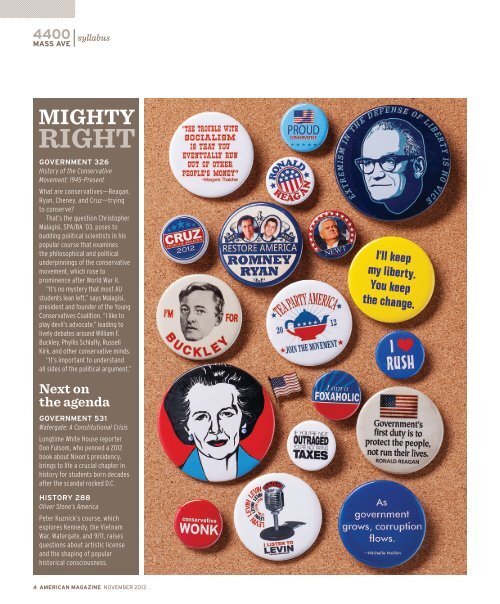You also want an ePaper? Increase the reach of your titles
YUMPU automatically turns print PDFs into web optimized ePapers that Google loves.
syllabus<br />
expert<br />
GOVERNMENT 326<br />
History of the Conservative<br />
Movement: 1945–Present<br />
What are conservatives—Reagan,<br />
Ryan, Cheney, and Cruz—trying<br />
to conserve?<br />
That’s the question Christopher<br />
Malagisi, SPA/BA ’03, poses to<br />
budding political scientists in his<br />
popular course that examines<br />
the philosophical and political<br />
underpinnings of the conservative<br />
movement, which rose to<br />
prominence after World War II.<br />
“It’s no mystery that most AU<br />
students lean left,” says Malagisi,<br />
president and founder of the Young<br />
Conservatives Coalition. “I like to<br />
play devil’s advocate,” leading to<br />
lively debates around William F.<br />
Buckley, Phyllis Schlafly, Russell<br />
Kirk, and other conservative minds.<br />
“It’s important to understand<br />
all sides of the political argument.”<br />
Next on<br />
the agenda<br />
GOVERNMENT 531<br />
Watergate: A Constitutional Crisis<br />
Longtime White House reporter<br />
Don Fulsom, who penned a 2012<br />
book about Nixon’s presidency,<br />
brings to life a crucial chapter in<br />
history for students born decades<br />
after the scandal rocked D.C.<br />
HISTORY 288<br />
Oliver Stone’s America<br />
Peter Kuznick’s course, which<br />
explores Kennedy, the Vietnam<br />
War, Watergate, and 9/11, raises<br />
questions about artistic license<br />
and the shaping of popular<br />
historical consciousness.<br />
3 MINUTES ON . . . The Minimum Wage<br />
David Kautter<br />
Managing director, Kogod Tax Center and<br />
executive in residence, Department of Accounting<br />
and Taxation, Kogod School of Business<br />
The minimum wage was enacted<br />
in 1938 as part of the Fair Labor<br />
Standards Act. It<br />
was 25 cents.<br />
Congress tried to<br />
enact one once before, but it was<br />
ruled unconstitutional in the<br />
early ’30s.<br />
Its primary<br />
purpose was<br />
to prevent<br />
employers from taking<br />
advantage of employees.<br />
Over time, other arguments<br />
have been made, including<br />
fairness. Some say<br />
it’s not fair for people<br />
who work hard<br />
to not get paid at<br />
least a “reasonable amount” of<br />
money. Another argument is<br />
redistribution:<br />
essentially, if the employees don’t<br />
get the money it will go to the<br />
business owners in the form<br />
of higher<br />
profits.<br />
A critical question<br />
has always been whether by<br />
increasing the federal minimum<br />
wage, which must be done by<br />
Congress, you raise the cost<br />
of labor,<br />
so that<br />
employers<br />
can afford less labor. Therefore<br />
businesses just don’t hire as<br />
many people because they can’t<br />
make enough money at the<br />
higher rate.<br />
The idea of a living<br />
wage—a higher minimum<br />
wage instituted by states,<br />
counties, or cities—emerged as a<br />
major issue in the late<br />
’90s. The highest at the moment<br />
is in San Francisco. The issue<br />
there is that the minimum wage<br />
is not what<br />
most would<br />
consider a<br />
living wage,<br />
and so while it sets<br />
a floor on what employers can<br />
pay, it’s not enough to live on.<br />
One of the challenges<br />
with the debate in Washington,<br />
D.C., has been that<br />
it has focused on a<br />
particular segment<br />
of employers—like Walmart—as<br />
opposed to all employers. The key<br />
challenge for cities in particular is<br />
that businesses can move out to<br />
the suburbs,<br />
where they can<br />
keep the same<br />
customers and pay less in wages.<br />
In the District, I think the<br />
weakness in the debate was that<br />
they picked out a piece in the<br />
market, so-called “big box<br />
retailers.” If it’s good<br />
policy, isn’t it good for everybody?<br />
If you can’t afford a wage of that<br />
magnitude in your city, then<br />
you’re probably better off not<br />
having a living wage policy.<br />
It’s estimated that only about<br />
50 percent of people earning<br />
minimum wage are part of<br />
families that<br />
make less<br />
than<br />
$40,000<br />
a year. The<br />
other half are<br />
teenagers or spouses, people<br />
who have other earners in the<br />
household making well above<br />
the minimum wage.<br />
When the minimum wage goes<br />
up, who pays? It can<br />
either be the owner of the<br />
business through smaller profits,<br />
or it can be added to<br />
the cost of the<br />
service or the good.<br />
The other issue<br />
with raising the wage is that<br />
people earning minimum wage<br />
tend to consume almost<br />
every dollar they make.<br />
What that’s going to do is create<br />
more demand in the market. You<br />
just hope that it doesn’t get so<br />
active that it<br />
doesn’t have an<br />
adverse impact on<br />
inflation.<br />
It’s a fascinating<br />
issue on which<br />
there are generally not a lot of<br />
crystal clear answers. It comes<br />
down more to philosophy than<br />
hard economics.<br />
4 AMERICAN MAGAZINE NOVEMBER <strong>2013</strong> LET’S TALK #AMERICANMAG 5


